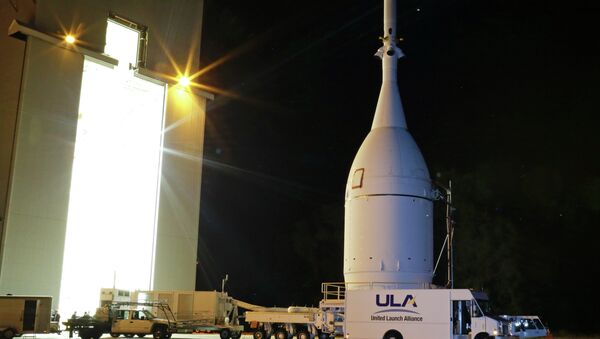MOSCOW, December 4 (Sputnik) — NASA is ready to take what it hails as the first step in mankind’s journey to Mars, with the launching of the Orion spacecraft Thursday; a craft designed to carry humans farther in space than ever before, AFP reports.
Orion, an unmanned capsule, will be hoisted aboard the United States’ largest rocket, the Delta IV Heavy made by United Launch Alliance. Engineers will keep a close eye on how it performs during the four-and-a-half hour flight.
The launch of the Orion spacecraft marks the first US spacecraft aimed at carrying people into deep space since the Apollo missions in 1960s and 1970s.
Some NASA officials believe the launch has galvanized the US space program, long constrained by government spending cutbacks and forced to rely on costly rides aboard Russian Soyuz rockets to reach the International Space Station.
The launch scheduled to 12:05 GMT from Cape Canaveral, Florida, will propel 739,000 kilograms spacecraft, rockets and fuel straight to space where the capsule will make two laps around the Earth before it will splash down in the Pacific Ocean.
The first orbit will be as high as the ISS, at an altitude of about 430 kilometers, while the second will soar 15 times higher, to an apogee of 5800 kilometers above the Earth.
The chief contractor of the Orion spacecraft is Lockheed Martin. The capsule was initially designed to take humans to the Moon under NASA’s Constellation program. In 2010, US President Barack Obama cancelled the initiative in favor of seeking deep space exploration. In order to complete the task, NASA has already spent billions of dollars on the Orion mission and a powerful rocket, the Space Launch System (SLS).
Potential future missions for Orion include a trip to lasso an asteroid and a flight to Mars by the 2030s.
"Thursday is the beginning of that journey, testing key systems — the riskiest systems I would say for Orion — before we have any people on board," said Mark Geyer, program manager for Orion.
"Assuming Congress or one of the next two presidents do not cancel SLS because of its inevitably ballooning costs, it’s more likely that the first SLS/Orion manned mission will occur closer to the middle part of the next decade," space analyst Marco Caceres of the Teal Group in Virginia told AFP.
Another key issue NASA has to deal with is safety for human explorers.
Thursday’s test launch is expected to demonstrate how Orion’s heat shield performs at it teaches temperatures of 2,200 Celsius on its way back to Earth at a speed of 32,000 kilometers per hour.
Besides, NASA engineers will gauge the effects of high-radiation on the crucial microelectronic parts of the spacecraft.



